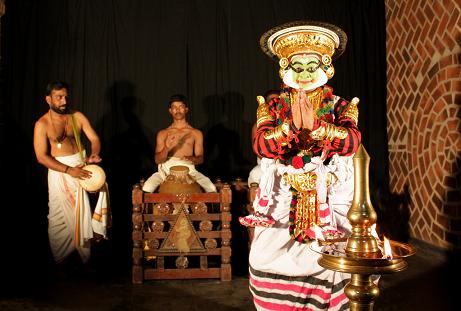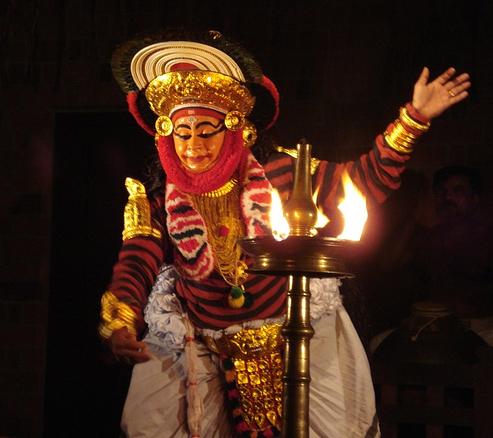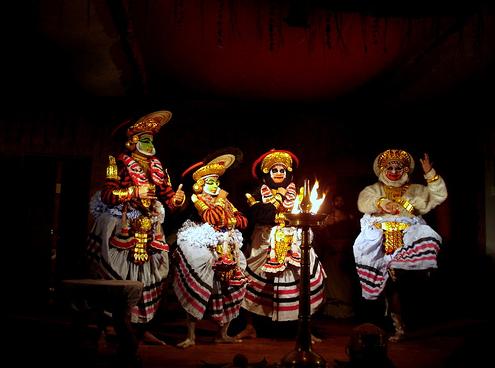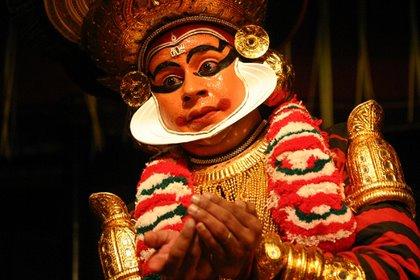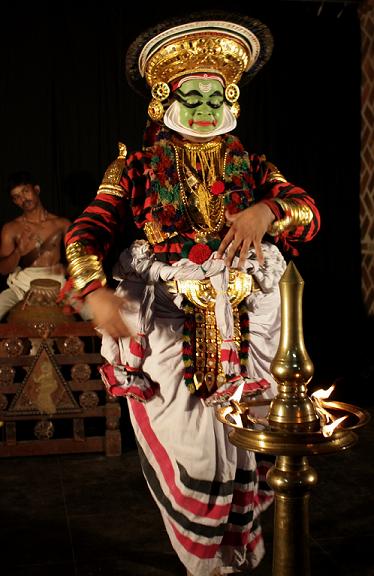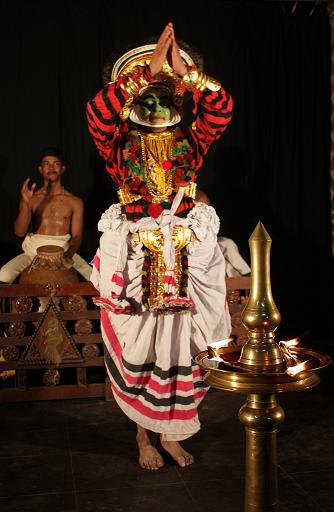
Archives
Contribute
| South Asian Art - In Memory Of Prashant H. Fadia |
Ranjani Saigal
10/30/2008
(To buy tickets to the PEM NEMA event on Nov 14 2008 , please go to http://www.lokvani.com/lokvani/cal.php?stage=1&event_id=6440)
“Akkalangalali Adi Bhuja Bala Vikram Shukran Nartanacharapathi Ravanan Yen Oru Chittan Vandu Pirandu Daraniyil(In the days past a strong intelligent man named Ravana was born in the world)†, declares the Chakkiar loudly as he describes the birth of the mighty Ravana. Sitting in a makeshift theater using his poetic skills, the Chakkiar uses satire to skillfully blend contemporary issues with tales from the Hindu epics to to inform and enlighten the audience. Watching this art form is indeed a thrilling experience.
The multitude of talents displayed by the Chakkiar is stunning. It is a holistic theater where, Angikam(body movements), Vachikam(music and poetry) and Aharyam (costume) are used in its fullest extent by the Chakkiar to convey the Satvik Abhinaya or pure thoughts.
This art form is part of a larger theatrical form called Koodiyattam [kutiyattam], meaning 'combined acting'. It is a Sanskrit drama presented in the traditional style in temple theatres of Kerala and is the only surviving specimen of the ancient Sanskrit theatre. It has an attested history of a thousand years in Kerala, but its origin and evolution are shrouded in mystery.
It seems that Kutiyattam is an amalgam of the classical Sanskrit theatre of ancient India and the regional theatre of Kerala. It is believed that Kulasekhara Varman Cheraman Perumal, an ancient king of Kerala, who ruled from Mahodayapuram (modern Kodungallur) reformed Koodiyattam, introducing the local language for Vidusaka and structuring presentation of the play to well defined units. He himself wrote two plays, Subhadraharana and Tapatisamvarana and made arrangements for their presentation on stage with the help of a Brahmin friend of him called Tolan. These plays are still presented on stage. Apart from these, the plays traditionally presented include Ascaryacudamani of Saktibhadra, Kalyanasaugandhika of Nilakantha, Bhagavadajjuka of Bodhayana, Nagananda of Harsa, and many plays ascribed to Bhasa including Abhiseka and Pratima. The Kutiyattam performance was confined to the temple precincts of Kerala in specially constructed theatres called Kutampalams.
Traditionally, the main musical instruments used in Koodiyattam are Mizhavu, Kuzhitalam, Etakka, Kurumkuzhal and Sankhu. Mizhavu, the most prominent of these, is a percussion instrument which is played by a person of the Ambalavas Nambiar caste, accompanied by Nangyaramma playing the kuzhithalam (a type of cymbal).
UNESCO (United Nations Educational, Scientific and Cultural Organization) recently honored this oldest surviving Sanskrit Theatre tradition of India and has acclaimed it as a “Masterpiece of Oral and Intangible Heritage of Humanity 2000â€.
Sri Sivan Namboodari (recipient of the National Sangeet Natak Academy Award) and his ensemble present this expressive form of Art along with excerpts from the film that features his Performance at the Peabody Essex Museum.
(To buy tickets to the PEM NEMA event on Nov 14 2008 , please go to http://www.lokvani.com/lokvani/cal.php?stage=1&event_id=6440)
You may also access this article through our web-site http://www.lokvani.com/
